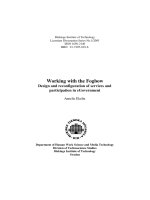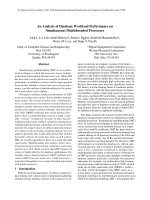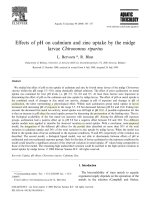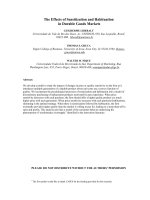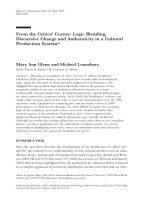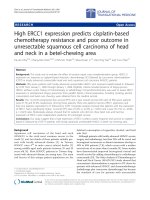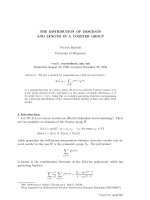Effects of ph and temperature on simultaneous nitritation, anammox and denitrification in a wetland treatment system receiving dairy wastewater
Bạn đang xem bản rút gọn của tài liệu. Xem và tải ngay bản đầy đủ của tài liệu tại đây (3.29 MB, 47 trang )
EFFECTS OF PH AND TEMPERATURE ON SIMULTANEOUS
NITRITATION, ANAMMOX AND DENITRIFICATION
IN A WETLAND TREATMENT SYSTEM
RECEIVING DAIRY WASTEWATER
by
Yuling He
A thesis
submitted in partial fulfillment
of the requirements for the
Master of Science Degree
State University of New York
College of Environmental Science and Forestry
Syracuse, New York
April 2011
Approved: Department of Environmental Resources Engineering
Wendong Tao, Major Professor
Charles Maynard, Chair
Examining Committee
Charles N. Kroll, Department Chair
S. Scott Shannon, Dean
The Graduate School
Gary Scott, Director, Division of
Environmental Resources Engineering
UMI Number: 1496418
All rights reserved
INFORMATION TO ALL USERS
The quality of this reproduction is dependent on the quality of the copy submitted.
In the unlikely event that the author did not send a complete manuscript
and there are missing pages, these will be noted. Also, if material had to be removed,
a note will indicate the deletion.
UMI 1496418
Copyright 2011 by ProQuest LLC.
All rights reserved. This edition of the work is protected against
unauthorized copying under Title 17, United States Code.
ProQuest LLC.
789 East Eisenhower Parkway
P.O. Box 1346
Ann Arbor, MI 48106 - 1346
Acknowledgements
It has been a great experience working on this research project with guidance and support
from my mentors, friends and family.
First I want to particularly thank my major professor Dr. Wendong Tao. I appreciate the
invaluable opportunity he offered me to work with him. I thank Dr. Tao for his inspiration,
insightful suggestions, timely advice throughout this research as well as the extreme patience he
showed on revising my thesis writing. Without his knowledge, great efforts and encouragements
my research will not be possible.
I would like to thank all those who have contributed to the completion of this degree: Chris
Norton for helping on wetlands operation, Maria B. Hosmer-Briggs for consulting on academic
writing and communication, and the examining committee members for their understanding and
valuable comments.
Finally, I want to thank my parents and sister for their continuous support, my boyfriend for
his faithful encouragements and also suggestions on statistical analysis, my lovely friends for
their smiles and words which helped me through many tough times.
ii
Table of Contents
List of Tables ................................................................................................................................... v
List of Figures ................................................................................................................................ vi
Abstract ......................................................................................................................................... vii
Chapter 1: Introduction ................................................................................................................... 1
References ................................................................................................................................... 3
Chapter 2: Literature Review .......................................................................................................... 5
1 Nitratation Inhibition ............................................................................................................... 5
2 Methods for pH Adjustment..................................................................................................... 9
3 Simultaneous Nitritation, Anammox and Denitrification ...................................................... 10
4 Fluorescent in situ Hybridization ............................................................................................11
References ................................................................................................................................. 12
Chaper 3: Manuscript .................................................................................................................... 15
Abstract ..................................................................................................................................... 15
1 Introduction ............................................................................................................................ 16
2 Materials and Methods ........................................................................................................... 18
2.1 Wetland Treatment System ............................................................................................. 18
2.2 Field Measurements and Chemical Analysis .................................................................. 19
2.3 Fluorescent in situ Hybridization .................................................................................... 19
2.4 Data Analysis .................................................................................................................. 20
iii
3 Results and Discussion .......................................................................................................... 21
3.1 Ammonium and Total Inorganic Nitrogen Removal....................................................... 22
3.2 Effects of Temperature .................................................................................................... 23
3.3 Effects of pH ................................................................................................................... 24
4 Conclusions ............................................................................................................................ 24
References ................................................................................................................................. 26
Tables ........................................................................................................................................ 29
Figures....................................................................................................................................... 31
Appendix ................................................................................................................................... 35
Chapter 4: Conclusions and Recommendations ........................................................................... 37
References ................................................................................................................................. 38
Vita ................................................................................................................................................ 39
iv
List of Tables
Table 1 Nitrogen removal rate of biofilters (BM1 and BM2) and free water surface wetlands
(CW1 and CW2) over four operational phases .............................................................. 29
Table 2 Plant growth in free water surface wetlands .................................................................. 29
Table 3 Relative abundance of AOB and anammox bacteria in biofilters and free water surface
wetlands at the end of Phase III ..................................................................................... 29
Table 4 Nitrogen removal performance in different wetland treatment systems......................... 30
v
List of Figures
Figure 1 Experimental setup of biofilters and free water surface wetlands. .............................. 31
Figure 2 Dynamics of pH, temperature and ammonium N removal excluding plant uptake in
free water surface wetlands. Closed circle-CW1; closed square-CW2. ....................... 32
Figure 3
Dynamics of pH, temperature and ammonium N removal in biofilters. ..................... 33
Figure 4 FISH micrographs of anammox bacteria and AOB in a biofilm sample from the biofilter
with higher pH values................................................................................................... 34
vi
Abstract
Y. He. Effects of pH and Temperature on Simultaneous Nitritation, Anammox and Denitrification
in a Wetland Treatment System Receiving Dairy Wastewater, 46 pages, 4 tables, 4 figures, 2011.
A wetland treatment system, composed of two biofilters followed by two free water surface
wetlands, was designed to enhance simultaneous nitritation, anammox and denitrification. It was
operated to evaluate effects of pH and temperature on nitrogen removal from dairy wastewater.
Furnace slag was utilized to increase pH. Nitritation and anammox bacteria accounted for about
70% of the bacteria in each unit. Temperature was the primary factor affecting nitrogen removal.
Significant pH effects were identified when temperature was below 18 ºC. Ammonium removal
rates were 1.10 and 0.86 g N/m2/d in the biofilters with pH at 8.2 and 7.7, respectively. At raised
pH values (8.2-8.5) and temperatures (28.7 ºC on average), a biofilter removed 2.49 g N/m2/d of
ammonium. The free water surface wetlands removed ammonium at 3.10 g N/m2/d when
temperature was between 26.0 ºC and 13.8 ºC, and 1.24 g N/m2/d at temperature between 19.1 ºC
and 15.1 ºC.
Keywords: anaerobically digested dairy manure, anammox, biofilter, constructed wetlands,
fluorescent in situ hybridization, nitrogen removal, nitritation, denitrification
Y. He
Candidate for the degree of Master of Science, April 2011
Wendong Tao, Ph.D.
Department of Environmental Resources Engineering, Division of Engineering
State University of New York College of Environmental Science and Forestry,
Syracuse, New York
Wendong Tao, Ph.D.___________________________________________________
vii
Chapter 1: Introduction
Ammonia is produced by human activities such as petrochemical, pharmaceutical, fertilizer
and food manufacturing, leachates produced by urban solid waste disposal sites, or animal
feeding operations. As a result, large quantities of wastewater containing ammonia are generated.
Since un-ionized ammonia is toxic to aquatic species and would cause eutrophication in natural
water bodies (Tchobanoglous et al., 2003), the removal of ammonia from wastewater has become a
worldwide emerging concern. Biological nitrogen removal process is one of the most common and
relatively cost-effective processes used to remove nitrogen from wastewater (Chung et al., 2006).
Biological nitrogen removal is usually accomplished via nitrification and denitrification
processes. Nitrification is a two-step aerobic process (Eq. 1 and 2) and is achieved by two
functional groups of bacteria. Ammonium oxidizing bacteria (AOB) oxidize ammonia to nitrite
(nitritation), while nitrite oxidizing bacteria (NOB) convert nitrite to nitrate (nitrataion):
Nitritation: NH4++ 1.5 O2 → NO2-+ H2O + 2H+
(1)
Nitratation: NO2- + 0.5 O2 → NO3-
(2)
Both AOB and NOB are aerobic, consuming 4.25 g of O2 per gram of ammonia-nitrogen
oxidized to nitrate–nitrogen. Due to this high oxygen demand for ammonia oxidation, aeration is
the main cost during this step (Ruiz et al., 2006).
In the denitrification stage, nitrate is reduced anaerobically to dinitrogen gas as equation 3
demonstrates:
8NO3- + 5CH3OH →4N2 + 10CO2 + 6H2O + 8OH(3)
Denitrifying bacteria are heterotrophic. Sufficient soluble organic matter (electron donor) is
needed to drive denitrification. This increases the operating costs in wastewater treatment plants
due to the cost of the additional carbon source and also the treatment of the surplus sludge that is
generated (Gong et al., 2008).
In recent years, more attention has been paid to emerging and cost-effective biological
nitrogen removal processes such as nitritation coupled with anaerobic ammonium oxidation
(anammox) (Strous et al., 1998):
Anammox: NO2- + NH4+ + 0.066HCO3- + 0.13H+ → 1.02N2 + 0.26NO3- + 2.03H2O +
0.066CH2O0.5N0.15
(4)
In anammox, nitrite formed by nitritation (Eq. 1) acts as the electron acceptor to
anaerobically oxidize ammonium. Since anammox bacteria are anaerobic the only oxygen
demand is from AOB. Theoretically, nitritation - anammox consumes 63% less oxygen as needed
for nitrification-denitrification process. On the other hand, both AOB and anammox bacteria are
chemoautotrophic that the oxidation of inorganic material does not yield as much energy as the
oxidation of organic carbon sources by heterotrophic bacteria. AOB and anammox bacteria, hence,
have a slow growth rate and low cellular yield (Strous et al., 1999). Due to this characteristic,
1
nitritation-anammox process has no need for additional organic substrates and also produces less
waste sludge.
Dairy Wastewater and Constructed Wetlands
Over the years, with the growing size of herds, dairy farmers are faced with treatment for
large amounts of manure including odor, nutrients, and pathogens. Anaerobic digestion has been
widely used in manure treatment, which converts organic carbon to biogas. Although anaerobic
digestion addresses both pathogen and odor issues and biogas can be used to generate heat and
electricity, it has very poor ammonia-nitrogen removal (Uludag-Demirer et al., 2008). Therefore,
the drainage from the agricultural land applied with digested manure contains high strength of
nitrogen which may threaten the sustainability of soil, groundwater as well as surface water
(Uludag-Demirer et al., 2005).
Constructed wetlands have provided a low-cost and low-maintenance alternative for treating
high strength agricultural discharges (Knight et al., 2000). This type of engineered system is
designed to utilize the natural processes involving wetland vegetation, soils, and their associated
microbial assemblages to assist in treating wastewater. They are designed to take advantage of
many processes that occur in natural wetlands, but do so within a more controlled environment
(Vymazal, 2007). Compared to conventional treatment methods, constructed wetlands are widely
accepted for their economic and environmental benefits such as relatively low capital cost, low
maintenance and no secondary pollution. They can also provide food and habitat for wildlife while
creating pleasant landscapes at the same time. Constructed wetlands have two basic types:
subsurface-flow and surface-flow wetlands. In subsurface-flow wetlands, water moves through a
gravel or sand medium on which plants are rooted. Unplanted subsurface-flow wetlands are
similar to biofilters. In surface-flow wetlands, water moves above the soil in a planted marsh or
swamp. Soil types include sand, silt and clay.
Anammox has already been positively identified in constructed wetland treatment systems
(Shipin et al., 2005). Obviously, the combination of constructed wetlands and anammox would be
both economically and environmentally beneficial. Research about anammox bacteria
performance in various types of constructed wetlands was carried out recently (Dong and Sun,
2007; Erler et al., 2008; Sun and Austin, 2007; Tao and Wang, 2009). However, nitrogen removal
from anaerobically digested dairy manure (ADDM) in constructed wetlands enhancing anammox
has not been reported.
2
References
Chung, J., Shim, H., Park, S., 2006. Optimization of free ammonia concentration for nitrite
accumulation in shortcut biological nitrogen removal process. Bioprocess Biosyst. Eng., 28,
275–282.
Dong, Z., Sun, T., 2007. A potential new process for improving nitrogen removal in constructed
wetlands—promoting coexistence of partial-nitrification and ANAMMOX. Ecol. Eng., 31, 69–78.
Erler, D., Eyre, B. D., Davision, L., 2008. The contribution of anammox and denitrification to
sediment n2 production in a surface flow constructed wetland. Environ. Sci. Technol., 42,
9144-9150.
Gong, Z., Liu, S.T., Yang, F.L., Bao, H., Furukawa, K., 2008. Characterization of functional
microbial community in a membrane-aerated biofilm reactor operated for completely autotrophic
nitrogen removal. Bioresour. Technol., 99, 2749–2756.
Knight, R.L., Payne, V.W.E, Borer R.E., Clarke, R.A., Pries, J.H., 2000. Constructed wetlands for
livestock wastewater management. Ecol. Eng., 15, 41-55.
Ruiz, G., Jeison, D., Rubilar, O., Ciudad, G., Chamy, R., 2006. Nitrification–denitrification via
nitrite accumulation for nitrogen removal from wastewaters. Bioresour. Technol., 97, 330-335.
Shipin, O., Kootatep, T., Khanh, N.T.T., Polprasert, C., 2005. Integrated natural treatment systems
for developing communities: low-tech N-removal through the fluctuating microbial pathways.
Water Sci. Technol., 51, 299–306.
Strous, M., Heijnen, J.J., Kuenen, J.G., Jetten, M.S.M., 1998. The sequencing batch reactor as a
powerful tool for the study of slowly growing anaerobic ammonium-oxidizing microorganisms.
Appl. Microbiol. Biotechnol., 50, 589–596.
Strous, M., Kuenen, J.G., Jetten, M.S.M., 1999. Key physiology of anaerobic ammonium
oxidation. Appl. Microbiol. Biotechnol., 65, 3248–3250.
Sun, G., Austin, D., 2007. Completely autotrophic nitrogen-removal over nitrite in lab-scale
constructed wetlands: Evidence from a mass balance study. Chemosphere, 68, 1120-1128.
Tao, W., Wang, J., 2009. Effects of vegetation, limestone and aeration on nitritation, anammox
and denitrification in wetland treatment systems. Ecol. Eng., 35, 836-842.
3
Tchobanoglous, G., Burton, F.L., Stensel, D.H., 2003. Wastewater Engineering: Treatment
Disposal and Reuse, 4th Ed. McGraw-Hill, New York.
Uludag-Demirer, S., Demirer, G. N., Chen, S., 2005. Ammonia removal from anaerobically
digested dairy manure by struvite precipitation. Process Biochem., 40(12), 3667-3674.
Uludag-Demirer, S., Demirer, G. N., Frear, C., Chen, S., 2008. Anaerobic digestion of dairy
manure with enhanced ammonia removal. J. Environ. Manage., 86(1), 193-220.
Vymazal, J., 2007. Removal of nutrients in various types of constructed wetlands. Sci. Total
Environ., 380(1-3), 48-65.
4
Chapter 2: Literature Review
The following sections attempt to review possible methods to optimize and quantify
anammox performance in constructed wetland treatment systems.
1 Nitratation Inhibition
To achieve a successful nitritation-anammox system, nitrite oxidizing bacteria (NOB) should
stably be inhibited in the reactor to reserve nitrite for anammox process, while still maintaining the
performance of ammonium oxidizing bacteria (AOB) at its maximum. This is because NOB
competes with AOB for dissolved oxygen also with anammox bacteria for nitrite and produces
nitrate which is toxic to aquatic life. A key factor for successful nitratation inhibition is to control
nitrite oxidation suppressors. Several studies have been carried out to investigate the effects of
alkalinity, dissolved oxygen (DO), temperature, pH and free ammonia (FA, NH3) on nitratation
inhibition.
1.1 Dissolved Oxygen
The oxygen affinity constants of ammonia and nitrite oxidizers are 0.3 and 1.1 mg/L,
respectively (Wiesman, 1994), which provides a possibility of achieving nitratation inhibition by
operating systems at low dissolved oxygen conditions. Many studies were done to verify this
hypothesis. Ruiz et al. (2003) proposed an optimum DO concentration of 0.7 mg/L. The
experiment was carried in an activated sludge unit treating synthetic wastewater (610 mg NH4+
N/L). Temperature and pH were maintained at 30 ºC and 7.85, respectively. DO concentration was
changed in steps from 5.5 to 0.5 mg/L by adjusting air flow level. They found that below DO of 0.5
mg/L ammonium started to accumulate and over DO of 1.7 mg/L complete nitrification to nitrate
occurred. Similar results were also obtained in other research (Ciudad et al., 2005; Wu et al.,
2008).
5
In aforementioned studies, the DO concentrations were accurately controlled by an air
compressor or flow-meter, which is difficult for constructed wetland systems. Although DO
concentration could be adjusted to a favorable range by changing water depth or vegetation, DO
concentration could only be used as an secondary factor in constructed wetlands.
1.2 Alkalinity
AOB, NOB and anammox bacteria are closely interlinked with common electron donor and
acceptors. All the three types of bacteria are chemolithotrophic. They require inorganic carbon for
their cell growth. By controlling alkalinity concentration, the elimination of NOB can be further
enhanced. In most of the applications involving anammox, alkalinity was adjusted by using
chemicals like NH4HCO3, KHCO3 and NaHCO3 (Chung et al., 2006; Tang et al., 2010; van de
Graaf et al., 1996). Stoichiometrically, nitrification consumes 7.14 g of alkalinity per g of NH4+-N
removed. Bagchi et al. (2010) proposed that an alkalinity consumption (alkalinity to ammonia
consumption) ratio of 7 or more is considered as an indicator of nitratation. They found that
maximum ammonia removal occurred at an influent alkalinity to ammonia ratio of 3.4 which
corresponds with the theoretical alkalinity consumption of 3.6 mg/mg NH4+ N in the
nitritation-anammox process.
1.3 Temperature
The ideal temperature for nitrification was from 20 ºC to 35 ºC (Hellinga et al., 1998). Dosta
et al. (2008) reported maximum AOB activity at 35-40 ºC in short-term adjustment. This strategy
has been applied at the industrial scale in the SHARON process (Fux et al., 2002, Hellinga et al.,
1998). However, there are also research pointed out that with proper adaptation, at temperatures
higher than 20 ºC, it is possible for AOB to out-compete NOB because of their greater growth rate
(Hao et al, 2002; Isaka et al., 2007). Nitratation inhibition could also occur when the temperature
was as low as 18 ºC. But if the temperature goes below 15 ºC, AOB would be affected as well
6
(Dosta, et al., 2008). For most of the non-tropical regions, temperature in constructed wetlands
during most time over a year is expected to be below 30 ºC, which would not lead to nitratation
inhibition.
1.4 pH
Compared to DO concentration and temperature, pH control is more pragmatic in constructed
wetland systems. pH has a significant effect on nitratation inhibition, since AOB and NOB prefer
different pH conditions. In the low pH range NOB were predicted to grow faster than AOB
(Hellinga et al., 1998). Therefore, more researchers controlled pH to inhibit NOB by adding, for
example, NaOH solution (Chung et al., 2006; Park et al. 2007).
Park et al. (2007) developed a bell-shaped empirical model to describe the pH-dependent
behavior of maximum specific substrate utilization rates (MSSUR, ˆqpH) of ammonium and nitrite
oxidation (Eq. 1):
q max
{1 cos[ ( pH pH opt )]}
2
w
( pH opt w pH pH opt w)
q pH
(1)
where qpH and qmax are the MSSUR at a given pH and the greatest MSSUR under the optimal pH,
respectively. ‘w’ is a range of pH change within which the MSSUR is larger than a half of the qmax.
Analysis of 7 experimental data sets showed that the optimum pH (pHopt) for AOB and NOB
was 8.2±0.3 and 7.9±0.4, respectively. The pH range (w) was 3.1±0.4 for AOB and 2.2±0.4 for
NOB, which meant that NOB was more sensitive to pH changes. Therefore, AOB enrichment and
nitratation inhibition may occur under pH conditions near or greater than the pHopt of AOB (pH
8.0-8.5).
7
1.5 Free Ammonia (FA)
The proportion of ionized ammonium (NH4+) and free ammonia (NH3, FA) in liquid is affected
by pH and temperature. FA concentration could be expressed by Eq.2 (Florida Department of
Environmental Protection, 2001):
[ FA]
where
17 [ NH 4 N ]
, mg/L
14 10 ( pKa pH ) 1
(2)
pKa = negative logarithm of the acid dissociation constant for NH4+.
Within the temperature range of 0oC-50oC and a pH range of 6.0 to 10.0,
pKa = 0.0901821 + 2729.92/Tk, Tk = oC + 273.2.
[NH4+-N] = Total ammonia concentration as N, mg N/L
It was reported that a certain concentration of FA at basic pH could restrain the activity of
NOB. However, AOB could be depressed at a high concentration of FA (Chung et al., 2006; Park,
2004; Ganigue et al., 2007). Therefore, the optimal range of FA concentration should not only
stabilize nitratation inhibition but also maintain maximum ammonium removal.
Chung et al. (2006) investigated the optimal FA concentration range using sludge from two
different sources, each with significantly different microbial distribution. They estimated the
conception of specific substrate utilization rates of ammonium oxidizers (qAO) and nitrite oxidizers
(qNO) under various FA concentrations, with temperature, pH, and DO maintained at 30±0.5ºC,
8±0.5, and 5 mg/L, respectively.
The highest AOB activity was observed when the FA concentration was 10 mg/L, and the rate
decreased slightly with increasing FA concentration. In case of NOB, the rate decreased
significantly with increasing FA concentration up to 5 mg/L. NOB was more sensitive to FA than
AOB. They concluded that the optimal FA concentration range for both stable nitratation
inhibition and maximum ammonium removal appeared to be 5-10 mg/L for the adapted sludge.
This conclusion was in accordance with other studies (Abeling et al., 1992; Balmelle et al., 1992).
8
Under the optimum pH condition (pH 8-8.5), as long as the FA concentration could be maintained
between 5-40mg/L, NOB can be efficiently restrained while AOB still performs well. According
to Eq. 2, at pH 8 and temperature 20ºC, influent ammonia concentration between 108-862 mg/L is
feasible in terms of FA concentration, theoretically.
2 Methods for pH Adjustment
Ammonia oxidation is superior to nitrite oxidation at pH 8-8.5 (Park et al., 2007). Since H+ are
continuously produced in nitritation process (Eq. 1, Chapter 1), some slow-dissolving sources of
alkalinity are needed to buffer pH.
In the previous studies on anammox in constructed wetlands, pH was not controlled (Dong
and Sun, 2007; Sun and Austin, 2007). The pH did not keep decreasing as H+ were produced by
nitrification. That could be attributed to photosynthesis of algae (Vymazal, 2007), the consumption
of H+ during anammox and the buffering of OH- produced by denitrification.
Constructed wetlands are commonly used due to its relatively low capital cost, low
maintenance and no secondary pollution. Therefore, chemical adjustments such as NaOH or HCl
are not adaptable. Tao and Wang (2009) applied limestone in surface-flow constructed wetland as
a natural source of alkalinity for anammox bacteria and pH buffer for nitritation. Wetlands used
limestone maintained significantly higher effluent pH (pH 8) than those used pavestone (pH 7.2).
They concluded that although limestone in the rooting substrate made no significant difference
from pavestone in ammonia and TN removal, it increased pH by 0.4-0.9, and raised the nitrite
production peak from 3.6mg N/L to 4.7mg N/L, which created better conditions for anammox.
More long-lasting and cheap alkalinity sources that could be applied in wetlands for nitrogen
removal were tested in 2008, by Renman et al. They compared the pH adjusting ability of seven
reactive filter materials. i.e., coarse amorphous slag (ASC), crystalline slag, coarse (CSC) and very
coarse (CSVC), limestone, opoka, Polonite® and sand. Each material was filled to a height of
50cm in 30-cm wide columns. The experiment was carried out indoors (temperature 20ºC) at the
9
Loudden wastewater treatment plant in Stockholm that receives domestic wastewater. 0.5 L/h of
wastewater was pumped from the plant and sprinkled equally over the column surface area every
other hour for 67 weeks with a daily hydraulic loading rate of approximately 85 L∙m2/d. All six
materials except for sand maintained pH 8-9 stably.
3 Simultaneous Nitritation, Anammox and Denitrification
Stoichiometrically, the anammox process removes only about 90% of the incoming
ammonium and produces nitrate which is about 10% of the influent ammonium. Nitrate as a
pollutant can affect human health (Kim-Shapiro et al., 2005) and can also be toxic to aquatic
organism (Romano et al., 2007). Moreover, substantial experiments showed that oxygen and
organic carbon can completely inhibit the anammox activity. The inhibition from organic carbon is
explained as follows: nitrite is an intermediary compound in nitrification and denitrification. When
nitritation produces nitrite, denitrification could start from this nitrite. Once there is enough
organic carbon present to support denitrifiers, anammox bacterial growth will be significantly
suppressed due to the weaker competition for nitrite (electron acceptor) and living space (Tang et
al, 2010; Dong and Tollner, 2003). Thus, anammox process is usually successfully obtained under
strictly anoxic and low organic carbon source conditions. However, most of the ammonium-rich
wastewater was produced with a certain concentration of COD. Researchers then started trying to
combine denitrification with nitritation -anammox processes for nitrogen removal from
wastewater with a high ammonium concentration and a low C/N ratio such as in municipal landfill
leachate and poultry manure (Dong and Tollner, 2003; Wang et al., 2010). It was shown that
anammox bacteria should not be threatened by denitrifiers when influent COD is as low as
100-150 mg/L (Tang et al., 2010; Chen et al., 2009). In this way, AOB consumes oxygen and
creates anoxic environment for anammox and denitrification microorganisms. Ammonium and
COD with the small amount of nitrate produced by anammox (Eq. 4, Chapter 1) are then removed
through nitritation-anammox and denitrification, respectively. This novel nitrogen removal
10
process is called SNAD (simultaneous nitritation, anammox and denitrification). The co-existence
of nitritation- anammox and denitrification were observed in constructed wetlands (e.g. Dong and
Sun, 2007; Tao and Wang, 2009) or other treatment systems (Chen et al., 2009; Wang et al., 2010).
Several researchers also investigated the contributions of SNAD to TN removal (e.g. Dong and
Tollner, 2003; Pathak et al., 2007).
4 Fluorescent in situ Hybridization
Nitrogen removal efficiency of wastewater treatment systems is ultimately determined by the
concentration and activity of related bacteria. Therefore, to characterize the structure of
microorganisms in treatment facilities is necessary to help understand removal mechanisms and
optimize operation parameters. Fluorescent in situ hybridization (FISH) is claimed to be the gold
standard for the detection of anammox organisms (Schmid et al., 2005). It is a cytogenetic
technique using fluorescent dye labeled rRNA oligonucleotide probes to detect and localize the
presence or absence of specific DNA or RNA sequences on chromosomes. Phylogenetic analysis
of anammox 16S rRNA sequences has shown that anammox bacteria form a monophyletic branch
within the phylum Planctomycetes. Anammox organisms possess linked 16S and 23S rRNA genes,
which can serve as a target for FISH (Schmid et al., 2005). The bacteria that have been hybridized
with the selected probes can be observed using fluorescence microscopy and ultimately
characterized in terms of the size and distribution of the bacteria, and the number of hybridized
cells (Delatolla et al., 2009). It provides a cultivation-independent method of monitoring bacterial
populations in biofilms.
11
References
Abeling U., Seyfrid C., 1992. Anaerobic-aerobic treatment of high strength ammonium waste
water-nitrogen removal via nitrite. Water Sci. Technol., 26, 1007-1015.
Balmelle B., Nguyen K., Capdeville B., Cornier, J.C., Deguin, A., 1992. Study of factors
controlling nitrite build-up in biological processes for water nitrification. Water Sci. Technol., 26,
1017-1025.
Bagchi, S., Biswas, R., Nandy, T., 2010. Alkalinity and dissolved oxygen as controlling
parameters for ammonia removal through partial nitritation and ANAMMOX in a single-stage
bioreactor. J. Ind. Microbio, Biot., 37(8), 871-876.
Chen, H., Liu, S., Yang, F., Xue, Y., Wang, T., 2009. The development of simultaneous partial
nitrification, ANAMMOX and denitrification (SNAD) process in a single reactor for nitrogen
removal. Bioresour. Technol., 100, 1548-1554.
Chung, J., Shim, H., Park, S., 2006. Optimization of free ammonia concentration for nitrite
accumulation in shortcut biological nitrogen removal process. Bioprocess Biosyst. Eng., 28,
275–282.
Ciudad, G.,Rubilar, O., Munoz, P., Ruiz, G., Chamy, R., Vergara, D., Jeison, D., 2005. Partial
nitrification of high ammonia concentration wastewater as a part of a shortcut biological nitrogen
removal process. Process Biochem., 40, 1715-1719.
Delatolla, R., Tufenkji, N., Comeau, Y., Lamarre, D., Gadbois, A., Berk, D., 2009. In situ
characterization of nitrifying biofilm: Minimizing biomass loss and preserving perspective. Water
Res., 43, 1775-1787.
Dong, Z., Sun, T., 2007. A potential new process for improving nitrogen removal in constructed
wetlands—promoting coexistence of partial-nitrification and ANAMMOX. Ecol. Eng., 31, 69–78.
Dong, X., Tollner, E. W., 2003. Evaluation of anammox and denitrification during
anaerobic digestion of poultry manure. Bioresour. Technol., 86(2), 139-145.
Dosta, J., Fernández, I., Vázquez-Padín, J. R., Mosquera-Corral, A., Campos, J. L., Mata-Álvarez,
J., Méndez, R., 2008. Short- and long-term effects of temperature on the anammox process. J.
Hazard. Mater., 154(1-3), 688-693.
12
Florida Department of Environmental Protection, 2001. Calculation of Un-Ionized Ammonia in
Fresh Water. Storet Parameter Code 00619. In: Chemistry Laboratory Methods Manual,
Tallahassee.
Fux, C., Boehler, M., Huber, P., Brunner, I., Siegrist, H., 2002. Biological treatment of
ammonium-rich wastewater by partial nitrification and subsequent anaerobic ammonium
oxidation (anammox) in a pilot plant. J. Biotechnol., 99(3), 295-306.
Ganigué, R., López, H., Balaguer, M. D., Colprim, J., 2007. Partial ammonium oxidation to nitrite
of high ammonium content urban landfill leachates. Water Res., 41(15), 3317-3326.
Hao, X., Heijnen, J. J., Van Loosdrecht, M. C. M., 2002. Model-based evaluation of temperature
and inflow variations on a partial nitrification–ANAMMOX biofilm process. Water Res., 36(19),
4839-4849.
Hellinga, C., Schellen, A., Mulder, J., van Loosdrecht, M., Heijnen, J., 1998. The SHARON
process: An innovative method for nitrogen removal from ammonium-rich waste water. Water Sci.
Technol., 37(9), 135-142.
Isaka, K., Sumino, T., Tsuneda, S., 2007. High nitrogen removal performance at moderately low
temperature utilizing anaerobic ammonium oxidation reactions. J. Biosci. Bioeng., 103(5),
486-490.
Kim-Shapiro, D. B., Gladwin, M. T., Patel, R. P., Hogg, N., 2005. The reaction between nitrite and
hemoglobin: The role of nitrite in hemoglobin-mediated hypoxic vasodilation. J. Inorg. Biochem.,
99(1), 237-246.
Park S., 2004. Multi-species nitrifying biofilm model including substrate inhibition and oxygen
limitation. PhD Dissertation, Hanyang University.
Park, S., Bae W., Chung, J., Baek, S., 2007. Empirical model of the pH dependence of the
maximum specific nitrification rate. Process Biochem., 42, 1671-1676.
Pathak, B. K., Kazama, F., Saiki, Y., Sumino, T., 2007. Presence and activity of anammox and
denitrification process in low ammonium-fed bioreactors. Bioresour. Technol., 98(11),
2201-2206.
Renman, A., Hylander, L., Renman, G., 2008. Transformation and removal of nitrogen in reactive
bed filter materials designed for on-site wastewater treatment. Ecol. Eng., 34, 207-214.
13
Romano, N., Zeng, C., 2007. Acute toxicity of sodium nitrate, potassium nitrate and potassium
chloride and their effects on the hemolymph composition and gill structure of early juvenile blue
swimmer crabs (Portunus pelagicus, Linneaus 1758) (Decapoda, Brachyura, Portunidae). Environ.
Toxicol. Chem., 26, 1955–1962.
Ruiz, G., Jeison, D., Chamy, R., 2003. Nitrification with high nitrite accumulation for the
treatment of wastewater with high ammonia concentration. Water Res., 37, 1371-1377.
Schmid, M.C., Maas, B., Dapena, A., van de Pas-Schoonen, K., van de Vossenberg, J., Kartal, B.,
et al., 2005. Biomarkers for In Situ Detection of Anaerobic Ammonium-Oxidizing (Anammox)
Bacteria. Appl. Environ. Microbiol., 71(4), 1677-1684.
Sun, G., Austin, D., 2007. Completely autotrophic nitrogen-removal over nitrite in lab-scale
constructed wetlands: Evidence from a mass balance study. Chemosphere, 68, 1120-1128.
Tang, C., Zheng, P., Wang, C. Mahmood, Q., 2010. Suppression of anaerobic ammonium
oxidizers under high organic content in high-rate Anammox UASB reactor. Bioresour. Technol.
101, 1762–1768.
Tao, W., Wang, J., 2009. Effects of vegetation, limestone and aeration on nitritation, anammox
and denitrification in wetland treatment systems. Ecol. Eng., 35, 836-842.
van de Graaf, A.A., De Bruijn, P., Robertson, L.A., Jetten, M.S.M., Kuenen, J.G., 1996.
Autotrophic growth of anaerobic ammonium-oxidizing microorganisms in a fluidized bed reactor.
Microbiol., 142, 2187-2196.
Vymazal, J., 2007. Removal of nutrients in various types of constructed wetlands. Sci. Total
Environ., 380(1-3), 48-65.
Wang, C., Lee, P., Kumar, M., Huang, Y., Sung, S., Lin, J., 2010. Simultaneous partial
nitrification, anaerobic ammonium oxidation and denitrification (SNAD) in a full-scale
landfill-leachate treatment plant. J. Hazard. Mater., 175(1-3), 622-628.
Wiesman, U., 1994. Biological nitrogen removal from wastewater. Adv. Biochem. Eng.
Biotechnol., 51,113-154.
Wu, X., Chen, L., Peng, Y., Wang, Y., Wang, P., 2008. Experimental study of nitrite
accumulation in predenitrification biological nitrogen removal process. Front. Environ. Sci. Eng.
(China), 2(2), 236-240.
14
Chaper 3: Manuscript
Abstract
Simultaneous nitritation-anammox-denitrification is a novel process for nitrogen removal from
wastewater with either high or low concentrations of organic carbon. This study designed an
innovative wetland treatment system, two biofilters followed by two free water surface wetlands,
for enhancement of simultaneous nitritation-anammox-denitrification. Effects of pH and
temperature were examined for ammonia removal from anaerobically digested dairy manure.
Marble chips were packed in the biofilters to buffer pH and supplement alkalinity. Furnace slag
was applied to one biofilter to further increase pH to 8.2-8.5 to examine pH effects on nitratation
inhibition and nitritation-anammox enhancement. Furnace slag was also placed on rooting
substrates in the free water surface wetlands to buffer pH. All four treatment units were drained
and fed every seven days. Fluorescence in situ hybridization analysis confirmed the existence of
nitritation and anammox bacteria which accounted for about 70% of the microbial community in
each unit. Temperature, which varied between 14.3ºC and 27.9ºC, was the primary factor
affecting nitrogen removal. pH effects were identified only when temperature was below 18 ºC in
the biofilters. Ammonium removal rates were 1.10 and 0.86 g N/m2/d in the biofilters with pH at
8.2 and 7.7, respectively. Ammonium removal rates at the elevated pH values (8.2-8.5) were 2.49
and 0.7 g N/m2/d in the biofilters at raised temperatures (28.7 ºC on average) and room
temperatures (19.0 ºC on average), respectively. The free water surface wetlands removed
ammonium at 3.10 g N/m2/d during phase II when temperature was between 26.0 ºC and 13.8 ºC,
and 1.24 g N/m2/d during phase III and phase IV at temperatures between 19.1 ºC and 15.1 ºC.
Keywords: anaerobically digested dairy manure, anammox, biofilter, constructed wetlands,
fluorescent in situ hybridization, nitrogen removal, nitritation, denitrification
15
1 Introduction
Anaerobically digested dairy manure (ADDM) contains high concentration of ammonia.
Traditionally, land disposal methods have been used to utilize nitrogen and phosphorus in manure.
However, the potential of exporting nutrients into water bodies makes it not sustainable (Wang et
al., 2010). In recent years, struvite precipitation and algae cultivation have been addressed to
recover nutrients in livestock wastewater. Struvite (MgNH4PO4·6H2O) is a slow releasing
fertilizer (Uludag-Demirer et al., 2005). In order to form struvite precipitates, large amounts of
chemicals are added to supplement magnesium and phosphorus, or chemical and thermochemical
pretreatment is applied to overcome interference (Uludag-Demirer et al., 2008; Jin et al., 2010;
Zhang et al., 2010). So far, the additional costs for pretreatment of dairy manure liquid make
struvite an impractical option (Zhang et al., 2010). Another way to recover nutrients from
ADDM is by cultivation of microalgae. Algae are harvested to serve as livestock feeding
supplements (Wilkie and Mulbry, 2002; Wang et al., 2010). However, the cost of drying the
harvested algae is a big drawback to implementing this technology (Wilkie and Mulbry, 2002).
Constructed wetlands, however, are cost-effective alternative for ADDM treatment. Constructed
wetlands have been employed for treatment of dairy wastewater in North America for more than
a decade (Knight et al., 2000; Sooknah and Wilkie, 2004; Vymazal, 2009).
Biological processes are mainly responsible for nitrogen removal in constructed wetlands
(Vymazal, 2007). Conventionally, biological nitrogen removal is accomplished through
nitrification and denitrification. The high cost for aeration, additional carbon source as well as
the treatment of surplus sludge are the main drawbacks of this process (Gong et al., 2008; Ruiz et
al., 2006). Anammox was discovered 16 years ago as a novel ammonia removal pathway (Mulder
et al., 1995). Anammox reaction is the oxidation of ammonium under anoxic conditions with
nitrite as the electron acceptor (Eq. 1) (Strous et al., 1998). Anammox can be integrated with
nitritation (Eq. 2) (Wiesman, 1994) which serves as a source of nitrite.
Anammox: 1.32NO2- + NH4+ + 0.066HCO3- + 0.13H+ → 1.02N2 + 0.26NO3- + 2.03H2O +
0.066CH2O0.5N0.15
(1)
Nitritation: 55 NH4++ 76 O2 + 109 HCO3- → C5H7O2N + 54 NO2-+ 57 H2O + 104H2CO3
(2)
Denitrification: 8NO3- + 5CH3OH →4N2 + 10CO2 + 6H2O + 8OH-
(3)
16
The novel nitritation-anammox process, in contrast to nitrification-denitrification, consumes
63% less oxygen. Meanwhile, both anammox and ammonium-oxidizing bacteria (AOB) are
chemoautotrophic with a low cellular yield (Strous et al., 1998), which eliminates the need for
additional organic substrates and generates less waste sludge. Anammox and nitratation produce
nitrate. Most of the ammonium-rich wastewater like ADDM contains a certain concentration of
biodegradable organic matter. In order to remove biochemical oxygen demand and nitrate while
oxidizing ammonium, nitritation-anammox needs to be coupled with heterotrophic denitrification
(Eq. 3) (Pathark et al., 2007; Chen et al., 2009).
Although simultaneous nitritation, anammox and denitrification (SNAD) has been reported
for nitrogen removal in constructed wetlands (Dong and Sun, 2007; Erler et al., 2008; Tao and
Wang, 2009), design considerations are largely unknown to enhance SNAD in wetland treatment
systems. To promote nitritation-anammox, nitrite oxidizing bacteria (NOB) should be inhibited to
reserve nitrite for anammox. This is because NOB competes with AOB for dissolved oxygen also
with anammox bacteria for nitrite. A key factor for successful NOB inhibition is to control nitrite
oxidation suppressors. AOB may out-compete NOB, either when pH is between 8.0-8.5 (Park et
al., 2007) or when temperature is higher than 25 ºC (Dosta, et al., 2008). Anammox is not affected
by denitrification when influent chemical oxygen demand is as low as 100-150 mg/L (Tang et al.,
2010; Chen et al., 2009). Rather, AOB consumes oxygen and creates anoxic micro-environments
for anammox and denitrifying bacteria in biofilms.
No study has yet been reported for integrating SNAD in wetland treatment systems that
receive wastewater with ammonium concentrations as high as in ADDM. In most of the earlier
studies on SNAD in wetland treatment systems, pH stayed around 7.0 (Dong and Sun, 2007; Sun
and Austin, 2007). Tao and Wang (2009) tried to adjust pH by applying limestone pellets to free
water surface wetlands, but no significant improvement on NH4+ and TIN removal was observed.
The seasonal variation of nitrogen removal through SNAD in wetland treatment systems has not
been explored yet. This paper presents an innovative wetland treatment system for enhancement of
SNAD to treat ADDM that contains high concentration of ammonium and low organic substrates.
Marble chips and furnace slag were utilized in biofilters and free water surface wetlands as
low-cost methods to manipulate pH. The main objectives of this study were: 1) to demonstrate the
applicability of biofilters and free water surface wetlands for ADDM treatment employing SNAD;
and 2) to evaluate the effects of pH and temperature on nitrogen removal via SNAD in biofilters
17

